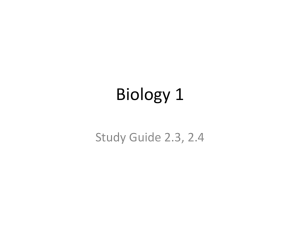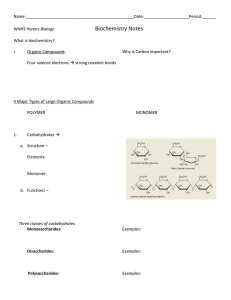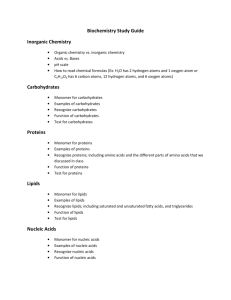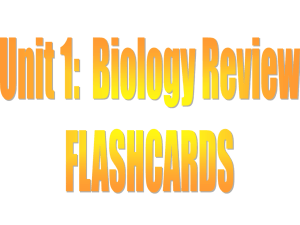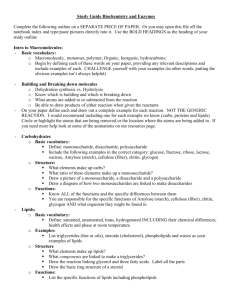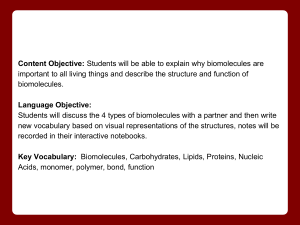Biomolecules Highlight Packet: Chemistry Worksheet
advertisement
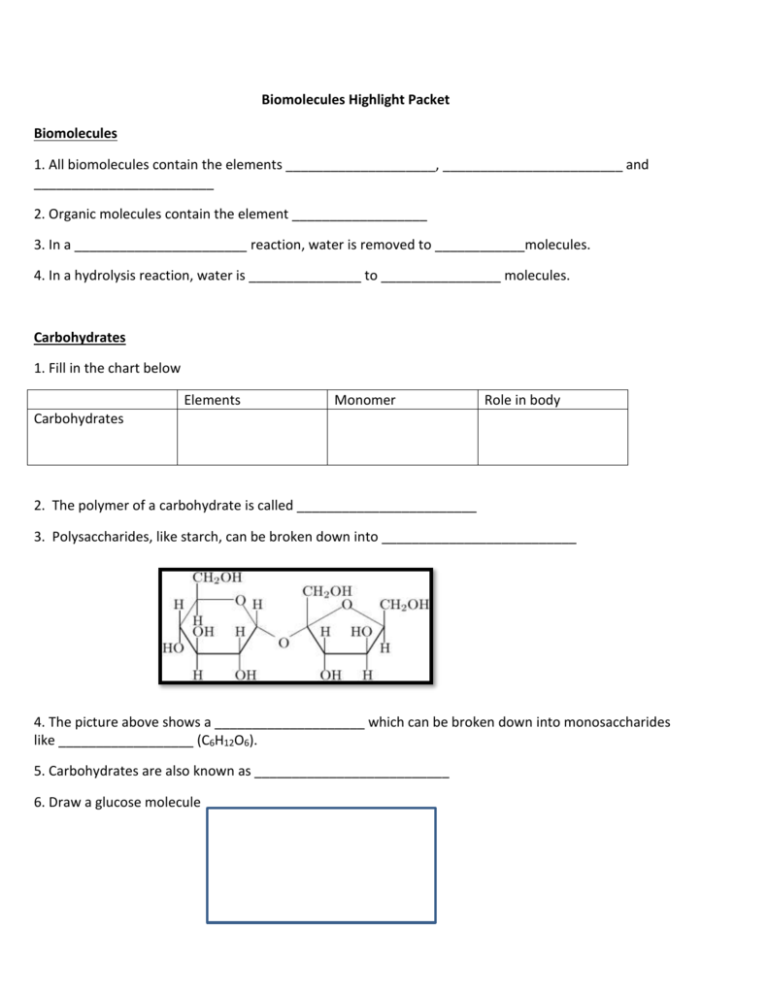
Biomolecules Highlight Packet Biomolecules 1. All biomolecules contain the elements ____________________, ________________________ and ________________________ 2. Organic molecules contain the element __________________ 3. In a _______________________ reaction, water is removed to ____________molecules. 4. In a hydrolysis reaction, water is _______________ to ________________ molecules. Carbohydrates 1. Fill in the chart below Elements Monomer Role in body Carbohydrates 2. The polymer of a carbohydrate is called ________________________ 3. Polysaccharides, like starch, can be broken down into __________________________ 4. The picture above shows a ____________________ which can be broken down into monosaccharides like __________________ (C6H12O6). 5. Carbohydrates are also known as __________________________ 6. Draw a glucose molecule Lipids 1. Fill in the chart below Elements Monomer Role in body Lipids 2. List examples of lipids __________________________________________________________ 3. Saturated fats are ________________ at room temperature and (HAVE / DO NOT HAVE) double bonded carbons. a. Draw a saturated Fat 4. Unsaturated fats are ______________ at room temperature and (HAVE / DO NOT HAVE) double bonded carbons. a. Draw an unsaturated fat 5. The two parts of a fat molecule are a ___________________ and 3 _____________________ 6. The __________________ is an important part of the cell membrane. Proteins 1. Fill in the chart below Elements Monomer Role in body Proteins 2. Proteins are formed from __________________ joined together by a ________________ bond. 3. Draw an amino acid Nucleic Acids 1. Fill in the chart below Elements Monomer Role in body Nucleic Acids 2. Nucleic acids store _______________ information that can be used to make ___________________. 3. What molecule is shown below? __________________ 4. Draw a nucleotide and label the three parts. i. ___________________________ ii. ___________________________ iii. __________________________ Enzymes 1. Label the enzyme, substrate and products in the picture below. 2. List the steps of the catalytic cycle of an enzyme. a. ___________________________________________________________ b. ___________________________________________________________ c. ___________________________________________________________ d. ___________________________________________________________ 3. _____________________ are proteins that speed up chemical reactions. 4. Enzymes are specific to a ____________________________. 5. Cells have many enzymes and each one is responsible for (THE SAME / DIFFERENT) chemical reaction(s). 6. Use the graph above to answer each of the following questions. i. T / F Each enzyme has a certain temperature that it works best. ii. T / F Increasing temperature always increases the reaction rate. ii. T / F Enzymes are not affected by temperature. EXTRA PRACTICE QUESTIONS (LEVEL ONLY) 1. . Refer to the illustrations above. The two products in the reaction are: A. Water and nucleic acid B. Polysaccharide and water C. Protein and water D. Monomer and water 2. The molecule on which an enzyme acts is called a(n) A. active site. C. organic molecule. B. inactive site. D. substrate. 3. Amylase is a digestive enzyme that breaks down starch into A. amino acids C. glucose B. polymers D. nucleic acids 4. Which of the following macromolecules is a prominent part of animal tissue that functions in insulation, helping animals conserve heat? A. carbohydrates B. lipids C. proteins D. nucleic acids



